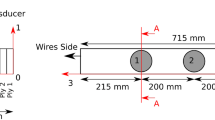Abstract
For 1–3 piezoelectric composite high-power transducers applied to FUS surgery, avoiding the electro-acoustic output performance fluctuating with the temperature is an important task. In this work, 1–3 type piezocomposites were fabricated with dice and fill method. The PZT4 piezoceramic was used as active phase, and mica powder modified epoxy resin E51 was used as passive phase: the mass ratio of the epoxy and mica powder was 10:x. Those composites were evaluated for power transducer applications with air backing and without front layer. The effect of mica powder modified polymer filler on the electro-acoustic output behavior and thermal stability of the transducer were detailed investigated. The results show that mica power could increase the storage modulus and the toughness of the polymer. As a result, an elevated kt of 0.7 was observed when the adding amount was 50 wt%. The electro-acoustic conversion efficiency (ηea) of the transducer substantial increased to 81–83% and with good thermal stability when x = 1–5. The research results show that adding mica powder in the filler materials was one of the potential methods to prepare high-power piezocomposite transducer.








Similar content being viewed by others
References
Y.T. Cheung, High-intensity focused ultrasound therapy. Best Pract. Res. Clin. Obst. Gynaecol. 46, 74–83 (2017)
H.P. Beerlage, G.J. Van Leenders, G.O. Oosterhof et al., High-intensity focused ultrasound (HIFU) followed after one to two weeks by radical retropubic prostatectomy: results of a prospective study. Prostate 39(1), 41–46 (2015)
J. Caloone, C. Huissoud, J. Vincenot et al., High-intensity focused ultrasound applied to the placenta using a toroidal transducer: a preliminary ex-vivo study. Ultrasound Obst. Gynecol. 45, 313–319 (2015)
B. Kanabec, H.O. Durum, Visual investigation of heating effect in liver and lung induced by a HIFU transducer. Phys. Procedia 70, 1225–1228 (2015)
D. Modelama, W.A. N’Djin, A. Battais et al., Thermal ablation of liver tumors by high-intensity-focused ultrasound using a toroid transducer. Results Anim. Exp. 1215(1), 224–227 (2009)
K. Okita, K. Sugiyama, K. Ono et al., Numerical study on high intensity focused ultrasound therapy using array transducer. Phys. Procedia 3(1), 315–322 (2010)
D. Melodelima, W.A. N’Djin, H. Parmentier et al., Toric HIFU transducer for large thermal ablation. Conf. Proc. IEEE Eng. Med. Biol. Soc. 2007, 230–233 (2007)
D. Suo, W. Guo, S. Lin et al., Thrombolysis using multi-frequency high intensity focused ultrasound at MHz range: an in vitro study. Phys. Med. Biol. 60(18), 7403–7418 (2015)
D. Melodelima, A. William, P.H. N’Djin et al., Ultrasound surgery with a toric transducer allows the treatment of large volumes over short periods of time. Appl. Phys. Lett. 91(19), 193901–193901 (2007)
S. Vaezy, V. Fujimoto, C. Walker et al., Treatment of uterine fibroid tumors in a nude mouse model using high-intensity focused ultrasound. Am. J. Obstet. Gynecol. 183(1), 6–11 (2000)
H. Jae Lee, S. Zhang, R.J. Meyer et al., Characterization of piezoelectric ceramics and 1–3 composites for high power transducers. Appl. Phys. Lett. 101(3), 1–4 (2012)
G.S. Chen, H.C. Liu, Y.C. Lin et al., Experimental analysis of 1–3 piezocomposites for high-intensity focused ultrasound transducer applications. IEEE Trans. Biomed. Eng. 60(1), 128–134 (2013)
S. Zhang, H.J. Lee, T.R. Shrout. Smart materials for high power applications. Proc. SPIE (2013)
M.P. Thi, A.C. Hladky-Hennion, H.L. Khanh et al., Large area 0–3 and 1–3 piezoelectric composites based on single crystal PMN-PT for transducer applications. Phys. Procedia 3(1), 897–904 (2010)
H. Lee, S. Zhang, Y. Bar-Cohen et al., High temperature high power piezoelectric composite transducers. Sensors 14, 14526–14552 (2014)
C. Richard, L. Goujon, D. Guyomar et al., Selecting passive and active materials for 1-3 composite power transducers. Ultrasonics 40(1), 895–901 (2002)
C. Richard, H.S. Lee, D. Guyomar, Thermo-mechanical stress effect on 1–3 piezocomposite power transducer performance. Ultrasonics 42, 417–424 (2004)
Z. Surowiak, D. Bochenek, D. Czekaj et al., Piezoceramic transducers with high thermal stability of the resonance frequency. Ferroelectrics 273(1), 119–124 (2002)
A.C.S. Parr, R.L. O’Leary, G. Hayward, Improving the thermal stability of 1–3 piezoelectric composite transducers. IEEE Trans. Ultrason. Ferroelectr. Freq. Control 52(4), 550–563 (2005)
L. Li, S. Zhang, Z. Xu et al., 1–3 Piezoelectric composites for high-temperature transducer applications. J. Phys. D 46(16), 165306 (2013)
A.C.S. Parr, R.L. O’Leary, G. Hayward et al., Improving the thermal stability of 1–3 piezoelectric composite transducers manufactured using thermally conductive polymeric fillers. IEEE Trans. Ultrason. Ferroelectr. Freq. Control 54(4), 550–563 (2005)
C. Wang, R. Zhang, Y. Jing et al., The effect of polymeric filler on poling behavior and thermal stability of 1–3 piezoelectric composites. J. Phys. D 49(2), 025301 (2016)
L. Li, S. Zhang, Z. Xu et al., 1–3 Ceramic/polymer composites for high-temperature transducer applications. Physical Status Solidi (a) 210(9), 1888–1891 (2013)
Acknowledgements
This research was supported by Technological innovation and application development in Chongqing (Foundation Project): No. cstc2019jscx-msxm1422.
Author information
Authors and Affiliations
Corresponding author
Additional information
Publisher's Note
Springer Nature remains neutral with regard to jurisdictional claims in published maps and institutional affiliations
Rights and permissions
About this article
Cite this article
Li, F., Chen, C., Li, W. et al. The electro-acoustic output behavior and thermal stability of 1–3 piezoelectric composite transducers applied to FUS surgery. J Mater Sci: Mater Electron 31, 12066–12073 (2020). https://doi.org/10.1007/s10854-020-03735-7
Received:
Revised:
Accepted:
Published:
Issue Date:
DOI: https://doi.org/10.1007/s10854-020-03735-7



